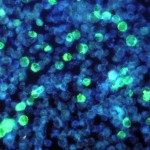Link to Pubmed [PMID] – 15608689
Oncogene 2005 Jan;24(4):541-51
Hepatoblasts are bipotent progenitors of both hepatocytes and cholangiocytes. The lack of stable in vitro culture systems for such cells makes it necessary to generate liver progenitor cell lines by means of immortalization. In this study, we describe the long-term behaviour of a clone of simian foetal hepatic progenitor cells immortalized by Simian virus 40 (SV40) large T-antigen (T-Ag) flanked by loxP sites. Immortalization was associated with the re-expression of telomerase activity, which decreased at late passages (population doubling 120) after more than a year in culture. This decrease was concomitant to telomere shortening and karyotypic instability. However, the chromosomes carrying the p53 gene remained intact and long-term immortalized progenitor cells maintained contact inhibition and proliferative properties. They also displayed the features of a normal bipotent phenotype. We constructed a retroviral vector expressing an inducible Cre recombinase and transferred it into the immortalized progenitors. Activation of the Cre recombinase by 4-hydroxy-tamoxifen induced SV40 T-Ag excision, leading to the death of cells expressing Cre recombinase. Immortalized progenitors at late passages stopped growing and eventually disappeared after transplantation into the livers of immunocompromised mice. These cells provide a novel model to study hepatic differentiation and carcinogenesis.

